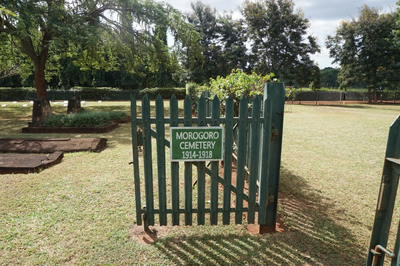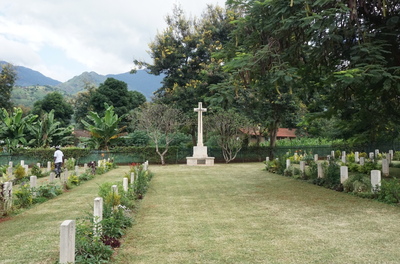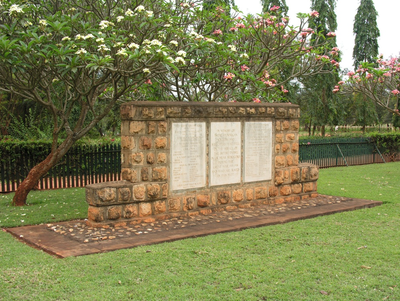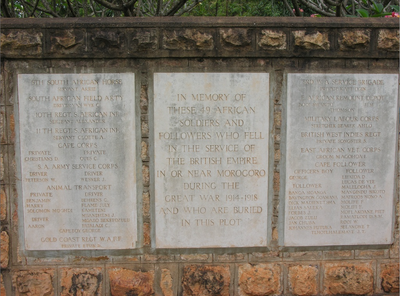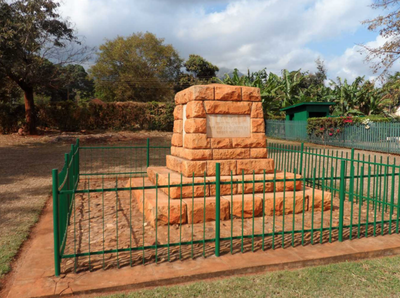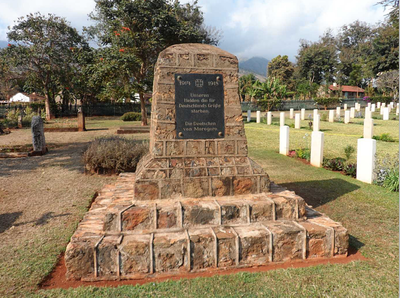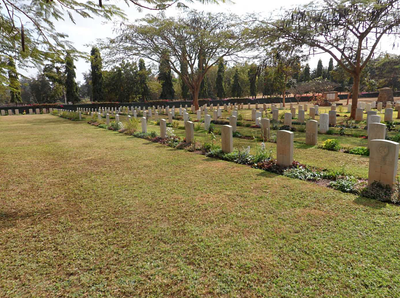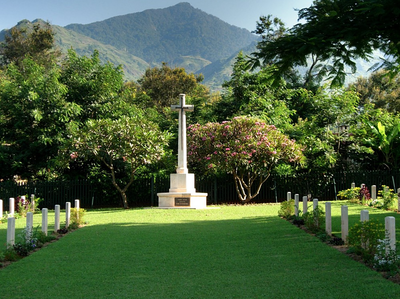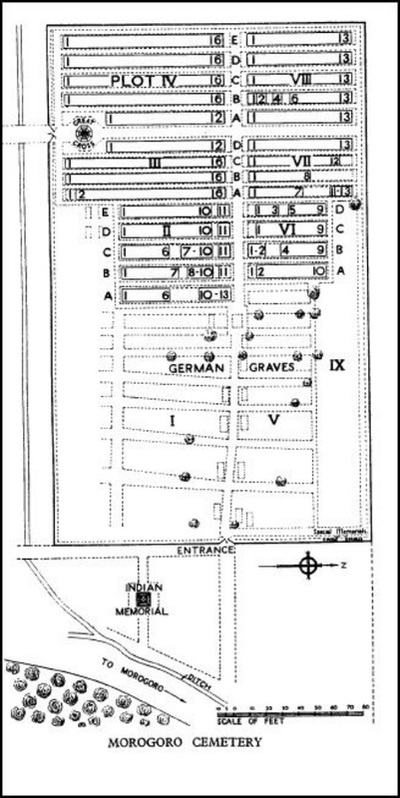MOROGORO CEMETERY
Morogoro
Tanzania
Location Information
Morogoro is situated 195 kilometres west of Dar-Es-Salaam.
At the large roundabout on the main road from Dar-Es-Salaam take the turning for the town centre. Follow this road straight through the town and come out the other side on a narrow road lined with mango trees. About 1 kilometre from the centre of town, turn right onto a rough track (this is marked by a CWCG direction sign). After approximately 100 metres, bear left at the fork (also signposted) and the cemetery is about 50 metres along the track on your right, set back amongst trees.
Visiting Information
Morogoro Cemetery is open every day between 06:00 and 18:00. Outside these hours the cemetery is locked with a coded padlock. If you intend to visit outside of the opening hours the code to the padlock can be obtained from our office in Kenya on 00 254 20260 4301. The opening hours of this office are Monday-Friday 08:30-12:30, 13:30-16:30 (closed weekends).
Wheelchair access to the cemetery is possible via main entrance.
Historical Information
At the outbreak of the First World War Tanzania was the core of German East Africa. From the invasion of April 1915, Commonwealth forces fought a protracted and difficult campaign against a relatively small but highly skilled German force under the command of General von Lettow-Vorbeck. When the Germans finally surrendered on 23 November 1918, twelve days after the European armistice, their numbers had been reduced to 155 European and 1,168 African troops.
Morogoro was occupied by Commonwealth forces on the 26 August 1916 and the German civil cemetery was taken over for Commonwealth war burials. Between the beginning of September 1916 and January 1919, 177 burials were carried out by the five medical units which were posted in the town and which were, at the outset, assisted by German medical personnel and civilians. After the Armistice, 169 graves were brought in from other burial grounds, including the following:
BUKU BUKU (or DINA BUKU) GRAVES, between Morogoro and the Mwuha river. The place was occupied in September 1916 and a medical unit was posted there.
DAKAWA (WAMI RIVER), between Morogoro and Handeni.
DUTHUMI MILITARY CEMETERY, between Morogoro and the Rufiji. The place was captured in September, 1916.
KIKEO ROAD CEMETERY, near Kisaki.
RUFIJI RIVER CEMETERY, near Chogowali.
TULO CEMETERY, on the Mikese-Duthumi road. The place was occupied in September 1916.
There are now 384 Commonwealth burials of the First World War in the cemetery, 4 of which are unidentified. There are 9 non Commonwealth burials here, including 5 unidentified.
Cemetery pictures used with the permission of the Commonwealth War Graves Commission
Morogoro is situated 195 kilometres west of Dar-Es-Salaam.
At the large roundabout on the main road from Dar-Es-Salaam take the turning for the town centre. Follow this road straight through the town and come out the other side on a narrow road lined with mango trees. About 1 kilometre from the centre of town, turn right onto a rough track (this is marked by a CWCG direction sign). After approximately 100 metres, bear left at the fork (also signposted) and the cemetery is about 50 metres along the track on your right, set back amongst trees.
Visiting Information
Morogoro Cemetery is open every day between 06:00 and 18:00. Outside these hours the cemetery is locked with a coded padlock. If you intend to visit outside of the opening hours the code to the padlock can be obtained from our office in Kenya on 00 254 20260 4301. The opening hours of this office are Monday-Friday 08:30-12:30, 13:30-16:30 (closed weekends).
Wheelchair access to the cemetery is possible via main entrance.
Historical Information
At the outbreak of the First World War Tanzania was the core of German East Africa. From the invasion of April 1915, Commonwealth forces fought a protracted and difficult campaign against a relatively small but highly skilled German force under the command of General von Lettow-Vorbeck. When the Germans finally surrendered on 23 November 1918, twelve days after the European armistice, their numbers had been reduced to 155 European and 1,168 African troops.
Morogoro was occupied by Commonwealth forces on the 26 August 1916 and the German civil cemetery was taken over for Commonwealth war burials. Between the beginning of September 1916 and January 1919, 177 burials were carried out by the five medical units which were posted in the town and which were, at the outset, assisted by German medical personnel and civilians. After the Armistice, 169 graves were brought in from other burial grounds, including the following:
BUKU BUKU (or DINA BUKU) GRAVES, between Morogoro and the Mwuha river. The place was occupied in September 1916 and a medical unit was posted there.
DAKAWA (WAMI RIVER), between Morogoro and Handeni.
DUTHUMI MILITARY CEMETERY, between Morogoro and the Rufiji. The place was captured in September, 1916.
KIKEO ROAD CEMETERY, near Kisaki.
RUFIJI RIVER CEMETERY, near Chogowali.
TULO CEMETERY, on the Mikese-Duthumi road. The place was occupied in September 1916.
There are now 384 Commonwealth burials of the First World War in the cemetery, 4 of which are unidentified. There are 9 non Commonwealth burials here, including 5 unidentified.
Cemetery pictures used with the permission of the Commonwealth War Graves Commission
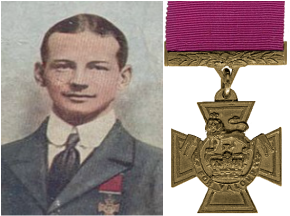
Captain John Fitzhardinge Paul Butler, V. C., D. S. O.
2nd Bn., Rifle Corps, attached to Gold Coast Regiment, W. A. F. F., died 5th September 1916, aged 27. Plot III. C. 3.
Son of Lt. Col. Francis John Paul Butler and the Hon. Elspeth Butler; husband of Alice Amelia Butler, of Apsley House, Portfield, Chichester.
Citation: An extract from "The London Gazette dated 23rd Aug., 1915, records the following:-"For most conspicuous bravery in the Cameroons, West Africa. On 17th November, 1914, with a party of 13 men, he went into the thick bush and at once attacked the enemy, in strength about 100, including several Europeans, defeated them, and captured their machine gun and many loads of ammunition. On 27th December, 1914, when on patrol duty, with a few men, he swam the Ekam River, which was held by the enemy, alone and in the face of a brisk fire, completed his reconnaissance on the further bank, and returned in safety. Two of his men were wounded while he was actually in the water".
2nd Bn., Rifle Corps, attached to Gold Coast Regiment, W. A. F. F., died 5th September 1916, aged 27. Plot III. C. 3.
Son of Lt. Col. Francis John Paul Butler and the Hon. Elspeth Butler; husband of Alice Amelia Butler, of Apsley House, Portfield, Chichester.
Citation: An extract from "The London Gazette dated 23rd Aug., 1915, records the following:-"For most conspicuous bravery in the Cameroons, West Africa. On 17th November, 1914, with a party of 13 men, he went into the thick bush and at once attacked the enemy, in strength about 100, including several Europeans, defeated them, and captured their machine gun and many loads of ammunition. On 27th December, 1914, when on patrol duty, with a few men, he swam the Ekam River, which was held by the enemy, alone and in the face of a brisk fire, completed his reconnaissance on the further bank, and returned in safety. Two of his men were wounded while he was actually in the water".

